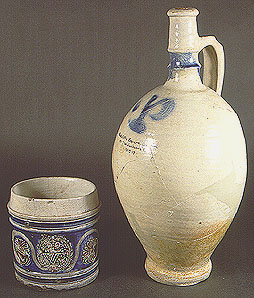| Fingerprints of the maker |
| What did the potter need? | |
| The raw materials necessary for the production of pottery are clay, water and fuel. Fillers and decorative materials may also be used. The properties of the clay derive from the parent rock. There are two types of clay: primary clay is acquired directly from the parent rock and is found in the place of its origin; secondary clay is decomposed rock which is weathered and deposited elsewhere. During transportation by glacial action, by river or by sea, clay picks up impurities and finally settles into beds of similar-sized particles. Stoneware clays form an example of secondary clay. Stoneware vessels were imported into England from France and the Rhineland, until the English learned the secret of making stoneware in the later seventeenth century. |

Westerwald Stoneware made from secondary clay associated with Coal Measures (fireclay) |
| Fingerprints ... | Why did they adapt the clay? |
|
© Copyright University of Oxford, Ashmolean Museum, 2000 The Ashmolean Museum retains the copyright of all materials used here and in its Museum Web pages. last updated: jcm/27-jun-2000 |